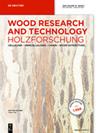Characterization of the bark of Protium tenuifolium Engl. from the Amazonian biome as a source of natural antioxidants
IF 1.6
3区 农林科学
Q2 FORESTRY
引用次数: 0
Abstract
The bark anatomy was analysed, as was the overall chemical composition (extractives, lignin, suberin, ash and polysaccharides), and a quantitative elemental analysis was performed of the bark and two tannin extracts (extracted with water only and with a mixture of water and Na作为天然抗氧化剂来源的亚马逊生物群落中的葳蕤(Protium tenuifolium Engl.)树皮的特性研究
分析了树皮的解剖结构以及总体化学成分(萃取物、木质素、单宁、灰分和多糖),并对树皮和两种单宁提取物(仅用水提取和用水与 Na2SO3 混合提取)进行了定量元素分析。还对树皮提取物的酚类成分和抗氧化活性进行了定量分析。结果表明,树皮由导电韧皮部、非导电韧皮部、流苏体、晶体和分泌细胞组成。平均化学成分为 15.9 % 的萃取物、35.3 % 的总木质素、1.9 % 的亚木质素、15.4 % 的灰分和 31.5 % 的多糖。仅用水提取的凝结单宁产量为 5.1%,用水和 Na2SO3 处理的凝结单宁产量为 8.1%。乙醇-水提取物的酚含量较高(112.6 毫克 GAE g-1 提取物)。树皮提取物显示出很强的抗氧化活性,对 DPPH 自由基的抑制率达到 83.5%,高于相同浓度下商业抗氧化剂 BHT 的 75.0%。这些结果表明,Protium tenuifolium 是亚马逊地区一种潜在的天然酚类化合物和抗氧化剂来源,可用于医疗目的和生产各种可持续产品,如化妆品。
本文章由计算机程序翻译,如有差异,请以英文原文为准。
求助全文
约1分钟内获得全文
求助全文
来源期刊

Holzforschung
工程技术-材料科学:纸与木材
CiteScore
4.60
自引率
4.20%
发文量
83
审稿时长
3.3 months
期刊介绍:
Holzforschung is an international scholarly journal that publishes cutting-edge research on the biology, chemistry, physics and technology of wood and wood components. High quality papers about biotechnology and tree genetics are also welcome. Rated year after year as one of the top scientific journals in the category of Pulp and Paper (ISI Journal Citation Index), Holzforschung represents innovative, high quality basic and applied research. The German title reflects the journal''s origins in a long scientific tradition, but all articles are published in English to stimulate and promote cooperation between experts all over the world. Ahead-of-print publishing ensures fastest possible knowledge transfer.
 求助内容:
求助内容: 应助结果提醒方式:
应助结果提醒方式:


